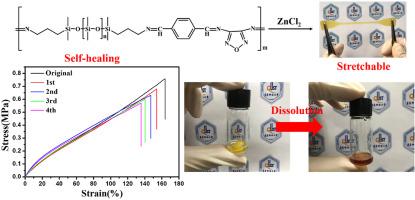Polymer Testing ( IF 5.0 ) Pub Date : 2021-01-22 , DOI: 10.1016/j.polymertesting.2021.107082 Kaiming Zhang , Chuanhui Gao , Jingyao Song , Chengxin Song , Zhe Wang , Yumin Wu , Yuetao Liu , Jiawen Sun

|
Bacterial resistance to antibiotics reduced the demand for antibiotics in the field of medical devices. Polymer antibacterial materials have shown great potential in the medical field. However, the treatment of materials after use is not environmentally friendly. Therefore, the development of dissoluble polymer antibacterial materials has become an urgent challenge. In this paper, an antibacterial polymer material with high self-healing ability and rapid dissolution is reported. The new material was formed by the Schiff base reaction and cross-linking of aldehyde group and amino in terephthalaldehyd (TA), 3,4-diaminofurazan (DAF) and α,ω-aminopropyl terminated polydimethylsiloxane (PDMS, Mn = 3000). The properties of the material were further enhanced by the coordination of zinc ion with nitrogen and oxygen atoms of 3,4-diaminofurazan. The antibacterial polymer material designed by us can be effectively repaired at 100 °C. The first repair efficiency was 89.5%. After repeated repair, its mechanical properties were not significantly reduced. E. coli and S.aureus were used to evaluate the antibacterial ability of the material. The antibacterial efficiency of the material was 99.9993% and 99.9997% respectively. This new idea solved the urgent problems in the current application, and provided guidance for the research of flexible antibacterial materials.
中文翻译:

具有可拉伸,自修复和抗菌性能的一种可溶性有机硅弹性体
对抗生素的细菌耐药性降低了医疗器械领域对抗生素的需求。高分子抗菌材料在医学领域显示出巨大的潜力。但是,使用后材料的处理对环境不利。因此,开发可溶性聚合物抗菌材料已成为迫在眉睫的挑战。在本文中,报道了具有高自修复能力和快速溶解的抗菌聚合物材料。这种新材料是通过席夫碱反应和对苯二甲酸醛(TA),3,4-二氨基呋喃(DAF)和α,ω-氨基丙基封端的聚二甲基硅氧烷(PDMS,Mn = 3000)中的醛基和氨基交联形成的。锌离子与3,4-二氨基呋喃酮的氮和氧原子配位可进一步提高材料的性能。我们设计的抗菌聚合物材料可以在100°C的温度下有效修复。首次修复效率为89.5%。反复修复后,其机械性能没有明显降低。大肠杆菌和金黄色葡萄球菌用于评估材料的抗菌能力。该材料的抗菌效率分别为99.9993%和99.9997%。这一新思路解决了当前应用中的紧迫问题,为柔性抗菌材料的研究提供了指导。分别为9993%和99.9997%。这一新思路解决了当前应用中的紧迫问题,为柔性抗菌材料的研究提供了指导。分别为9993%和99.9997%。这一新思路解决了当前应用中的紧迫问题,为柔性抗菌材料的研究提供了指导。











































 京公网安备 11010802027423号
京公网安备 11010802027423号